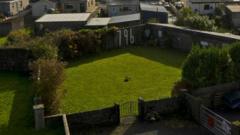What Led to the Secret Mass Grave of Hundreds of Irish Babies?

Uncovering the Secrets of St Mary's Home: A Journey into the Past
The heart-wrenching story of St Mary's Home in Tuam, County Galway, is a chilling reminder of a dark chapter in Ireland's history. For decades, the lives of countless women and children were marred by stigma and neglect, culminating in the tragic fate of hundreds of babies believed to be buried in a mass grave. This article delves into the discoveries made by amateur historian Catherine Corliss, the subsequent investigation, and the ongoing excavation efforts to uncover the truth behind the hidden past. It also reflects on the implications of these findings for survivors and families affected by the legacy of St Mary's Home.
Understanding St Mary’s Home: A Brief History
St Mary’s Home operated from 1925 until 1961, functioning as a church-run institution primarily for women who were deemed socially unacceptable due to having children outside of marriage. The home was a refuge for these women, yet it became a place of sorrow, where many children were separated from their mothers shortly after birth.
The Environment of St Mary’s Home
The environment in St Mary’s Home was harsh, with many women and children subjected to strict rules and isolation. The nuns of the Bon Secours Sisters ran the institution, and reports suggest that conditions were far from ideal. Women who were already vulnerable faced further marginalization and stigmatization from society.
The Deaths of Children at St Mary’s
Between 1925 and 1961, over 796 children are known to have died at St Mary’s Home, with the first reported death occurring in 1915. The reasons for these deaths ranged from neglect to medical complications, but many went unrecorded or were attributed to vague causes such as "congenital idiot" or other terms reflecting the era's inadequate understanding of health.
The Discovery of the Mass Grave
The quest for truth regarding the fate of these children began with Catherine Corliss, who, through her research, stumbled upon the shocking possibility of a mass grave near the former site of St Mary’s Home. Her journey highlights the significance of local history and the importance of seeking truth in the face of adversity.
The Initial Investigations
In 2005, Catherine began her local history course, driven by a desire to understand the past of her community. Her inquiries soon led her to focus on the children of St Mary’s. Initial responses to her questions were met with suspicion, as many locals were unwilling to discuss the home’s history.
The Turning Point: A Caretaker’s Revelation
During her investigation, Catherine spoke to a cemetery caretaker who revealed startling information about a location near a children's playground, where it was rumored that bones had been discovered years earlier. This revelation prompted Catherine to dig deeper into historical records. Her subsequent research uncovered maps indicating a “sewage tank” in the area, which fueled her suspicions further.
The Evidence of a Hidden Tragedy
As Catherine continued her research, she obtained a list of all the children who had died at St Mary’s Home. To her shock, the list contained 796 names. In a desperate attempt to verify their burial locations, she combed through cemetery records in Galway and neighboring counties, only to find no trace of these children. This lack of records made it increasingly likely that they had been buried in an unmarked grave, possibly within the defunct sewage tank.
Community Reactions and Challenges
When Catherine's findings were made public in 2014, they were met with skepticism and hostility from some members of the community. The revelation of such a tragic history was difficult for many to accept, especially given the stigma surrounding the women and children who had lived at St Mary’s Home.
Eyewitness Accounts: Testimonies of the Past
As the investigation progressed, the testimony of local residents provided further evidence of the horrors that had taken place at St Mary’s. One significant account came from Mary Moriarty, who recounted chilling details of discovering remains in the area during her childhood. Her account, along with others, strengthened the case for an excavation of the site.
Investigative Findings and Confirmation
In 2017, an Irish government investigation confirmed Catherine’s findings through a test excavation, which revealed “significant quantities of human remains.” The confirmation that these remains belonged to infants and young children was a devastating yet necessary acknowledgment of the truth that had long been hidden.
The Ongoing Excavation: A Quest for Closure
With the confirmation of human remains, a full excavation of the site began, expected to take approximately two years. This painstakingly delicate process seeks to recover the remains with utmost care to maximize the possibility of identification.
Challenges Faced During Excavation
Daniel MacSweeney, the head of the excavation operation, emphasized the complexity of the task ahead. The remains are likely to be mixed together, making identification a significant challenge. Moreover, the emotional weight of the excavation process is felt by many, especially those who have been personally affected by the history of St Mary’s.
Implications for Survivors and Families
The excavation and subsequent findings carry profound implications for survivors and families who have been affected by the legacy of St Mary’s Home. Many feel a sense of loss and yearning for connection with siblings or relatives they never had the chance to meet.
The Role of Advocacy Groups
Organizations like the Tuam Babies Family Group, established by survivors and relatives, have been instrumental in advocating for recognition and justice for the children of St Mary’s. Their efforts have helped to give a voice to the children who were once silenced and forgotten.
Moving Forward: A Reflection on Healing and Atonement
The excavation at Tuam is not merely a search for remains but a journey toward healing for the community and acknowledgment of past injustices. It serves as a reminder of the need for compassion and understanding as society grapples with the repercussions of historical neglect and stigmatization.
Remembering the Lost Children
As the excavation continues, it is crucial to remember the names and stories of those who were lost. Each child represents a life cut short and a potential that was never realized. The ongoing efforts to uncover the truth and provide closure to families affected by this tragedy highlight the importance of addressing historical injustices.
Conclusion: A Call to Action
The story of St Mary’s Home in Tuam is a poignant reminder of the need for compassion and understanding in our society. As we reflect on the lives of those affected by this tragedy, we are called to ensure that such injustices never happen again. The excavation efforts not only seek to recover remains but also to honor the memories of the children who deserve to be remembered.
As we move forward, let us advocate for justice, support survivors, and acknowledge the past, paving the way for healing and reconciliation. How can we ensure that the stories of these lost children are never forgotten? #TuamBabies #HistoricalJustice #RememberTheLost
FAQs about the St Mary's Home Excavation
What was St Mary's Home in Tuam?
St Mary's Home was a church-run institution in Tuam, County Galway, that housed women and children between 1925 and 1961, primarily those who had fallen pregnant outside of marriage.
How many children are believed to be buried at the site?
It is estimated that around 796 children died at St Mary's Home, with many believed to be buried in an unmarked mass grave near the former sewage tank.
What prompted the excavation of the site?
The excavation was prompted by the findings of amateur historian Catherine Corliss, who uncovered evidence suggesting a mass grave through historical research and eyewitness accounts.
What challenges are faced during the excavation process?
The excavation team faces numerous challenges, including the delicate nature of the remains, which are likely mixed together, and the emotional weight of uncovering such a tragic history.
How can the community support the excavation efforts?
Community support can come in the form of advocacy for justice, raising awareness about the history of St Mary's Home, and providing emotional support to survivors and families affected by this legacy.
Published: 2025-07-12 23:27:12 | Category: technology



